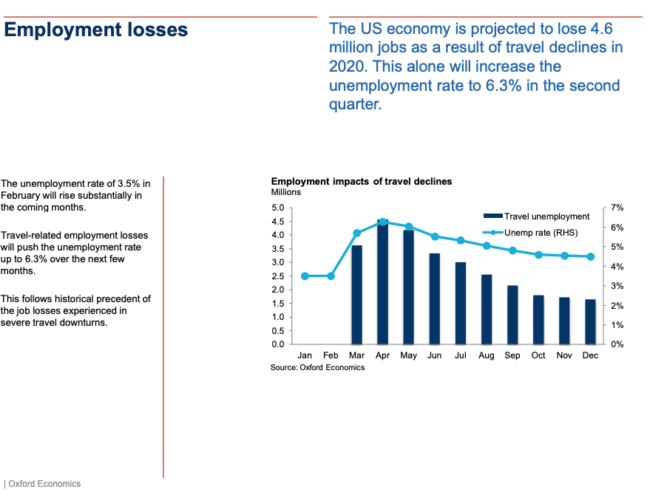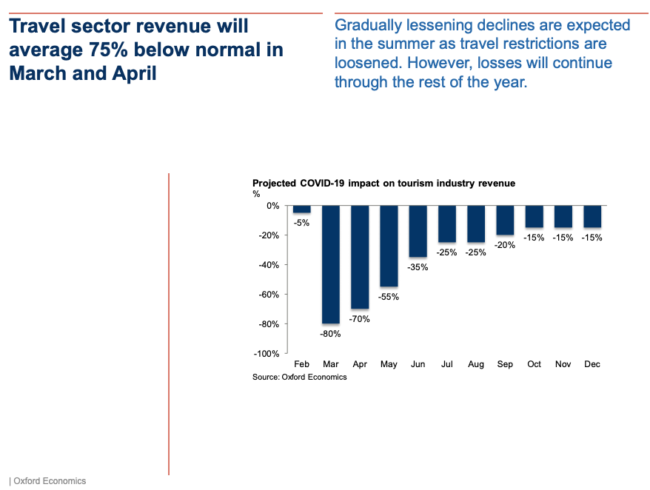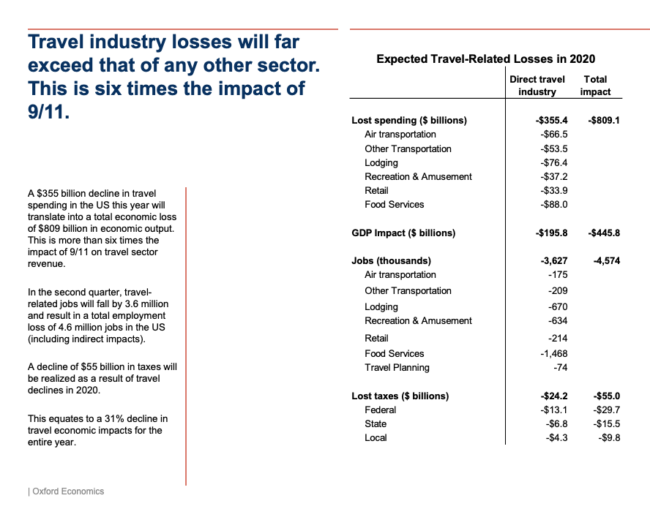Today US President Trump said that the cost of shutting down US travel and tourism industry (hotels, restaurants, airlines) is about 30 billion dollars a month, and the government is preparing to compensate for the loss. The president pointed out that it’s not the fault of a hotel or restaurant owner, that the guests are no longer showing up. “The government stopped it”, President Trump noted.
A new analysis released Tuesday by the U.S. Travel Association projects that decreased travel due to coronavirus will inflict an $809 billion total hit on the U.S. economy and eliminate 4.6 million travel-related American jobs this year. Earnings in March and April will be 75% below normal.
The dire impact numbers, prepared for the U.S. Travel Association by Tourism Economics, were presented by U.S. Travel Association President and CEO Roger Dow at a Tuesday White House meeting with President Trump, Vice President Pence, Commerce Secretary Wilbur Ross, and other travel leaders.
“The health crisis has rightly occupied the public’s and government’s attention, but a resulting catastrophe for employers and employees is already here and going to get worse,” Dow said Tuesday. “Travel-related businesses employ 15.8 million Americans, and if they can’t afford to keep their lights on, they can’t afford to keep paying their employees. Without aggressive and immediate disaster relief steps, the recovery phase is going to be much longer and more difficult, and the lower rungs of the economic ladder are going to feel the worst of it.”
Dow noted that 83% of travel employers are small businesses.
Other notable findings in the travel impact analysis:
- Total spending on travel in the U.S.— transportation, lodging, retail, attractions and restaurants—is projected to plunge by $355 billion for the year, or 31%. That is more than six times the impact of 9/11.
- The estimated losses by the travel industry alone are severe enough to push the U.S. into a protracted recession—expected to last at least three quarters, with Q2 2020 being the low point.
- The projected 4.6 million travel-related jobs lost would, by themselves, nearly double the U.S. unemployment rate (3.5% to 6.3%).
“This situation is completely without precedent,” Dow said. “For the sake of the economy’s long-term health, employers and employees need relief now from this disaster that was created by circumstances completely out of their control.”
At the Tuesday White House meeting, Dow urged the administration to consider $150 billion in overall relief for the broader travel sector. Among the suggested mechanisms:
- Establish a Travel Workforce Stabilization Fund
- Provide an Emergency Liquidity Facility for travel businesses
- Optimize and modify SBA loan programs to support small businesses and their employees.
Oxford Economics, in coordination with its Tourism Economics subsidiary company, modeled the expected downturns in the US travel industry in 2020 as a result of Coronavirus. We then modeled the economic impacts of these travel industry losses in terms of GDP, unemployment, and taxes.
Travel Industry Losses A decline of 31% for the entire year is expected.
This includes a 75% drop in revenue over the next two months and continued losses over the rest of the year reaching $355 billion. GDP Losses Travel industry losses will result in a cumulative GDP impact of $450 billion in 2020.
We project the US economy to enter a protracted recession based on the expected downturn in travel alone. The recession is likely to last at least three quarters with the lowest point in the second quarter of 2020. Tax Losses A decline of $55 billion in taxes will be realized as a result of travel declines in 2020.
Employment Losses The US economy is projected to lose 4.6 million jobs as a result of travel declines in 2020. The unemployment rate of 3.5% in February will rise substantially in the coming months. Travel-related employment losses alone will push the unemployment rate up to 6.3% over the next few months.
The Time Opportunity The greatest opportunity to mitigate these losses is to reduce the time required for a recovery.
While typical recovery times from a disease related crisis range from 12-16 months, this can be shortened through strategic promotions and support of the travel industry. We analyzed two scenarios for shortening the duration of losses.
SCENARIO 1: FULL RECOVERY BEGINS IN JUNE Scenario assumes full recovery is achieved in June.
Each month from June-December offers a potential average gain of $17.8 billion in GDP and $2.2 billion in taxes. Total benefits would tally $100 billion in travel industry revenue, $15 billion in taxes, and 1.6 million jobs restored. SCENARIO 2: 50% RECOVERY BEGINS IN JUNE Scenario assumes that recovery is accelerated by 50% (relative to expected performance) beginning in June. In this scenario, each month offers a potential gain of $8.9 billion in GDP and $1.1 billion in taxes.
Total benefits would tally $50 billion in travel industry revenue, $7.7 billion in taxes, and 823,000 jobs restored

screen shot 2020 03 17 at 09 35 03

screen shot 2020 03 17 at 09 34 53

screen shot 2020 03 17 at 09 34 41

screen shot 2020 03 17 at 09 34 29

screen shot 2020 03 17 at 09 34 19

screen shot 2020 03 17 at 09 34 10

screen shot 2020 03 17 at 09 34 02

screen shot 2020 03 17 at 09 33 52






